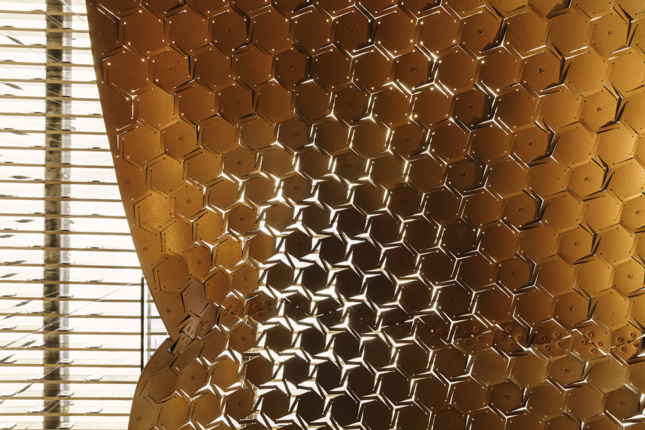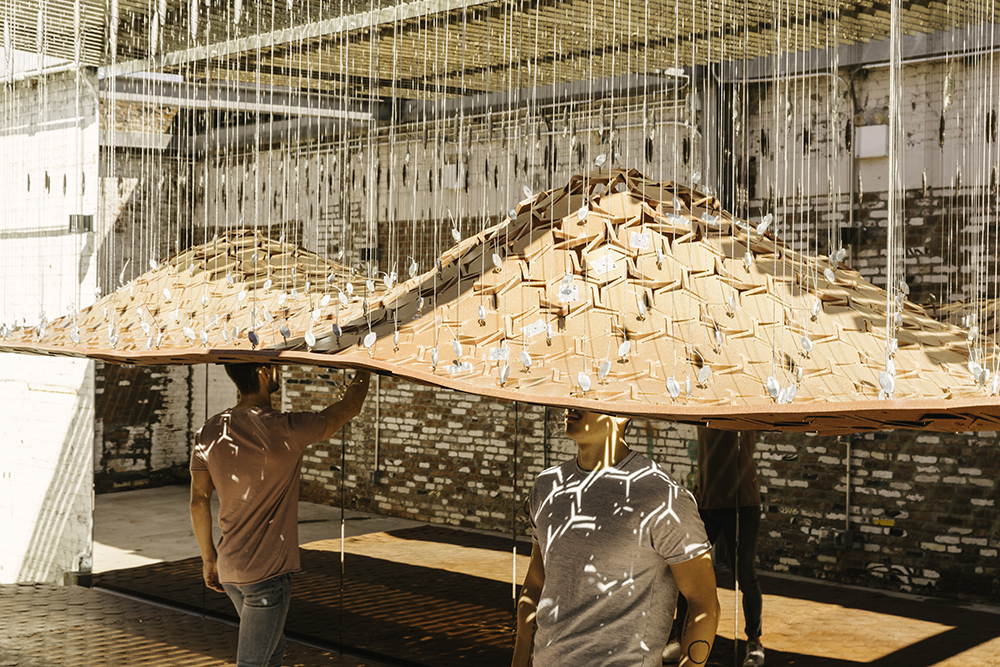Today, most people live in cities—artificial structures that determine how we move through space and relate to others and the world around us. But, all too often these cities feel fixed, designed and determined by larger powers that shape a landscape that the average denizen has little direct influence over. So what would a responsive city, one that worked like a natural ecosystem and subsumed participants in its very fabric, look like? This is the question that Nassia Inglessis, founder of Studio INI, is provoking in her installation Urban Imprint, now on display in Brooklyn at A/D/O by MINI.
A 340-square-foot pavilion, Urban Imprint invites visitors to move all over a field of brick-red, water-jet-cut rubber-concrete composite tiles that sinks slightly underneath one’s feet, in turn deforming a hidden web of laser-cut steel below. Above, a web of that same brick-red material deforms upwards, rising in direct proportion to the weight of participants on the platform. The entire project was conceived and prototyped in just under six months, fabricated in Athens and then shipped to New York for its unveiling during New York Design Week.

So often, Inglessis said, our cities are a “design that somebody has given us and we have to navigate.” From the grid of Manhattan to the walls of a building, “there is no imprint that you are leaving behind, no evidence that you’ve been there.” This lack of interaction leaves citizens feeling “muted,” Inglessis said, “you feel just part of somebody else’s design, and we often feel that we are quite lonely in the city.” Urban Imprint is designed to resist this static notion of architecture. “It doesn’t have a final form and it never will because the human element is what completes the design.” Plus, when more than one person steps on the surface, it reconfigures entirely how you relate to one another—your sightlines and ground shift and move, and the effect of other participants in this microcosm of urban space is quite palpable. You’re all participating in remaking this “space.”
While “there are a lot of digital tools and fabrication and computational design that went into [Urban Imprint], the actual end result is completely analog,” Inglessis explained. A series of pulleys with cables hidden behind the red-hued mirrors, a color chosen to accentuate the brick facade of the former industrial space, operate the entire process. In function, Urban Imprint is like “a physical megaphone,” suggested Inglessis—taking the deformation of its participants and expanding it four times above their head, helping visitors imagine what it would be like to “have your urban environment give evidence of your presence.”

Speaking on the choice of creating a analogue, mechanical final form, Inglessis reflected: “Although I had the knowledge and tools of all these amazing new capabilities that have opened up from computational design and digital fabrication tools [both of which were used to design and fabricate the steel and rubber-concrete components], I felt there was so much activity moving us towards living in a headset.” Instead, she said, “we should look at technology and the new digital tools as a means to an end, rather than an end itself.”
So often, beyond just simulating the “real world” on screens and headsets, many new mixed-reality technologies just overlay digital elements onto a physical world that’s “still pretty static.” Instead of augmented reality, Inglessis proposes “augmented materiality,” a sort of “new analog” that blends old and new fabrication, production, and experiential tools to create new possibilities in our physical, urban world. In Urban Imprint, she says, “the material itself has the ability to transform, to be dynamic, to create interaction, and to be seamless.”
Urban Imprint was realized by Inglessis with the help of Manos Vordonarakis and the Studio INI team. It will be on view at A/D/O in Greenpoint, Brooklyn, until September 2.
